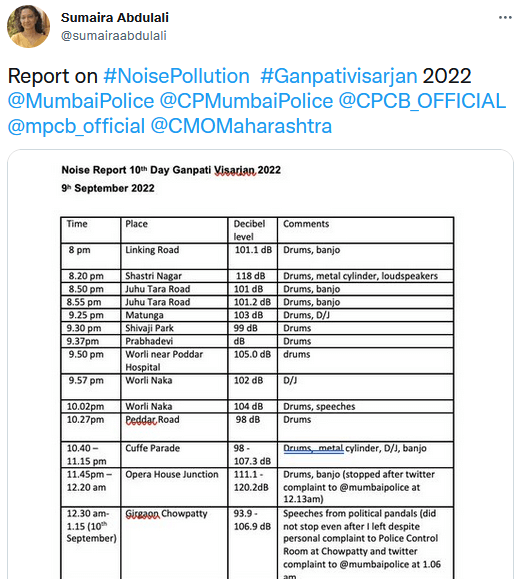Mumbai city celebrated Ganesh Chaturthi with great splendour after almost two years of low-key celebrations. During COVID lockdowns, social distancing meant the absence of large gatherings, even on festival days. This year’s vigorous celebrations included banjos, metal cylinders beaten with metal hammers and loudspeakers during processions for Ganesh Visarjan in Sarvajanik pandals of the city. These instruments inevitably raised noise levels. It became a cause for concern for all Mumbai residents as they grappled with the health impacts of noise.
In 2016, the Bombay High Court passed a comprehensive Judgement and Order to enforce the Noise Pollution Rules. The Court also monitored the implementation of their orders thereafter. Before the court order, DJs using loudspeakers and generators mounted on trucks were common at most processions during Visarjan. The government banned these thereafter and the ban continues till now. However, this year, even the DJ ban was violated in a few places on the final Visarjan day. Loudspeakers amplified the banging of drums. These processions passed through sensitive areas like hospitals and residential areas as well.
Pockets with high noise levels
Awaaz Foundation measured noise levels during processions across different parts of Mumbai. Permitted noise limit in residential areas is 55 decibels, which was violated across the city. On the fifth day of visarjan, we hit 115 decibels. This was recorded at Babulnath corner of Marine Drive. The second highest level was in Bandra, where we recorded 112 decibels.

Citizens sent us complaints from several parts of the city. Agitated residents also raised complaints via Tweets tagging authorities on Twitter.
On the final day of Visarjan, the highest noise levels at 120.2dB were at the Opera House. These also violated the time limit beyond midnight. This, despite the State Government extending the time limit from the normal limit of 10 pm for the festival. The music stopped after Awaaz Foundation made a Twitter complaint to Mumbai Police at 12.13 am.
However, at Girgaon Chowpatty along the immersion route, loudspeakers from political pandals continued beyond the period of my recording at about 1.25 am on September 10th. I also personally visited the Police Control Room at Girgaon Chowpatty and raised a Twitter complaint to Mumbai Police at 1.06 am.
The highest decibel level on the 10th visarjan day in 2021 was 93.1dB. In 2020 it was 100.7 dB and in 2019 was 121.3 dB.

Role of law-enforcement authorities
In Maharashtra, the second largest number of cases (after wildlife crime) filed under the Environment Protection Act were against noise pollution in 2019. The Mumbai Police has set up grievance mechanisms to address citizens’ complaints which are mostly effective. But when they consider issues “sensitive”, enforcement of Noise Rules lags. This leads to arbitrary enforcement of the Rules.
Read more: Explainer: The roles and responsibilities of police stations in Mumbai
Violations of Noise Rules require uniform enforcement to be effective. Unfortunately, the Ministry of Environment, Forests and Climate Change in 2017 de-notified Silent Zones by an amendment to the Noise Pollution Rules. Even though decibel restrictions are in place, enforcement is further hindered by this notification.
Efforts by citizens to reduce noise levels
Over the past 20 years of the anti-noise pollution movement, a large number of individual residents have become vigilant and proactive in complaining against noise pollution. Many pandals of Sarvajanik Ganpatis have also become highly concerned about developing environmentally friendly practices. However, despite the increased proactive efforts of all, these are insufficient without government regulation and encouragement towards safer celebrations. Today, everyone acknowledges that loud noise is bad, including RWAs, citizens and authorities.
Read more : Photo Essay: Ganesh Chaturthi during a pandemic
There have been significant changes in the complaint mechanism due to sustained pressure from citizens and court orders and even the enforcement authorities (Police) have become vigilant. Maybe 20 years ago, the authorities viewed such efforts to reduce noise as negative but today they recognise the gravity of the problem looking at the volume of complaints and the distress that noise causes to people.
Implications for humans and animals
High noise levels cause hearing loss, heart disease, high blood pressure, and adversely impact mental health. Recent studies link noise pollution to cancer. Noise also affects sleep, causing a host of other problems related to sleep deprivation. Studies show that noise impacts learning outcomes in children and that children fall behind in their reading ability when exposed to noise in the classroom.
Our bodies have also weakened due to COVID with many complaining of reduced ability to handle stress post-illness. We are experiencing the ill effects of noise pollution more severely now than before.
20 years ago, people used to think that Indians are used to loud noise and our bodies have become used to it. But that is far from true as our bodies are unable to adapt to rising pollution and these rapid changes are affecting us severely.
Way forward
Families and communities come together during festive celebrations. As a community and with respect to all, our celebrations need to account for health implications of noise pollution. Each of us needs to reduce our own noise pollution footprint, to educate our families and neighbours and to take action to complain effectively if required.
A free downloadable App ‘Noise Tracker’ on our mobile phones can inform us of actual decibel levels. A screenshot sent to the police on @mumbaipolice initiates action to enforce the rules. The police has taken action based on citizens’ complaints over the last decade. Only citizens’ action can help enforce the law.
(Writing assistance provided by Lalita T.)